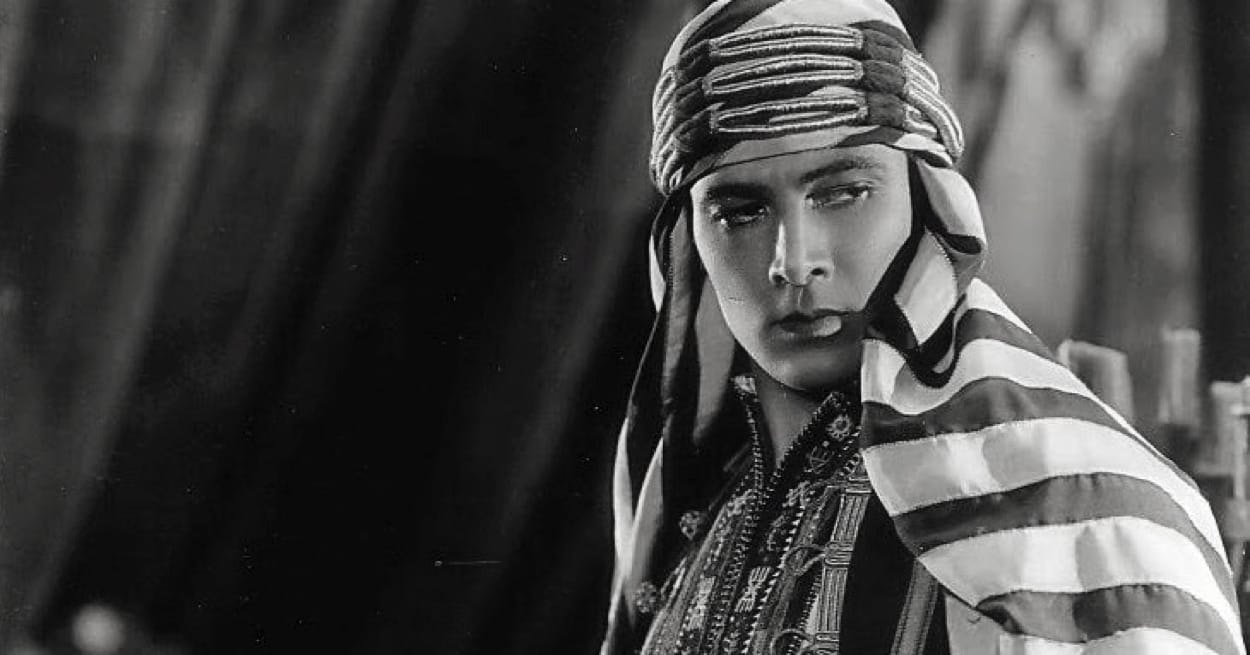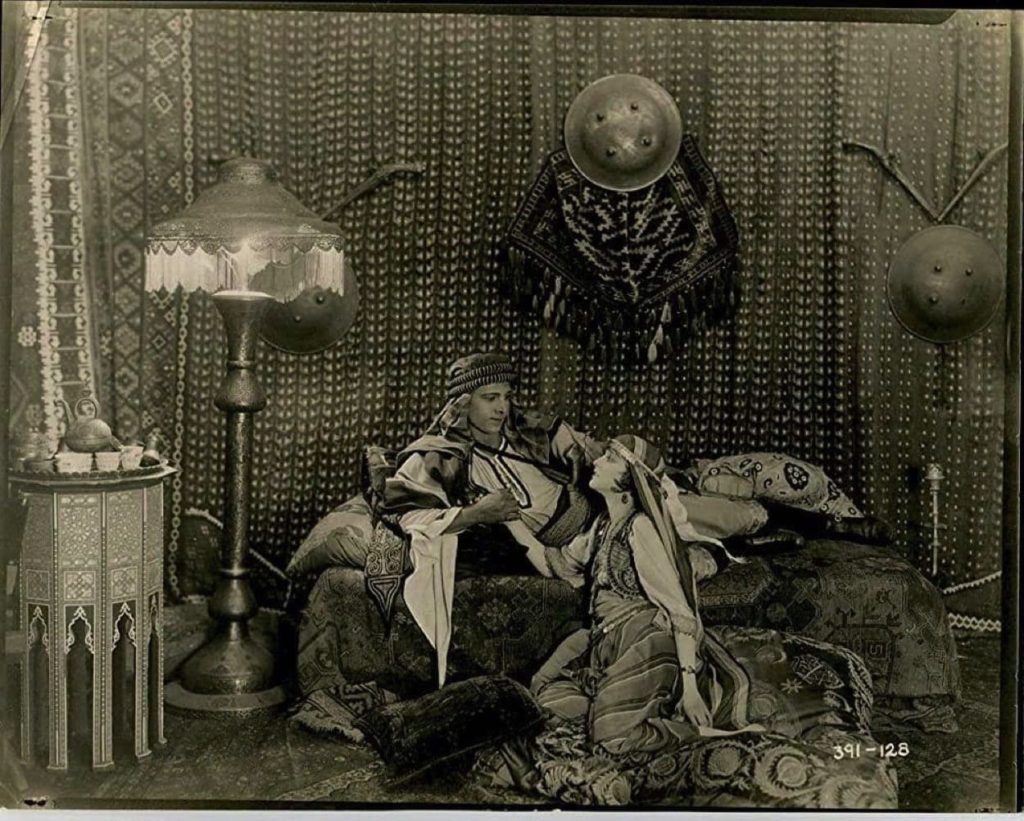Rudolph Valentino had two big films in 1921. The Four Horsemen of the Apocalypse, by far the biggest grossing film of the year, was the one that made him a star. But The Sheikh was even more important. It made Valentino so famous that we still talk of him today, long after the auras of fellow stars like Norma Talmadge and Wallace Reid have faded.
The Four Horsemen gave Valentino the “Latin lover” tag but The Sheikh made it stick, something that Valentino – striving to have a varied career – struggled against before bowing to the inevitable in 1926 with Son of the Sheikh. In an intense but short time at the top, that was his last film. Though he didn’t know it at the time Valentino would die six weeks after it opened from an infection after an operation that should have been routine. He was 31.
Born Rodolfo Alfonso Raffaello Pierre Filiberto Guglielmi di Valentina d’Antonguella, Valentino’s career blazed bright but short, his untimely death only polishing his now eternally young image. A gay icon (a “pink powder puff” according to one newspaper article at the time), a big hunk of masculinity, the Great Lover, hair brilliantined down – Vaselino, they called him – big, expressive eyes deliberately flashing to suggest high emotion, the ambiguous star.
1921 was a busy year, with five Valentino films in cinemas. As well as The Sheikh and The Four Horsemen of the Apocalypse (a tale of love against the background of the First World War), he made Uncharted Seas (a B movie contractual obligation), The Conquering Power (a romantic drama based on Balzac’s novel Eugénie Grandet) and Camille (a torrid romance co-starring the equally exotic Alla Nazimova).
But, to The Sheikh, in those days pronounced Sheek rather than Shake – as evidence, the Famous Players-Lasky Corporation (which eventually became Paramount) held a Sheikh Week in November 1921 to celebrate the success of the film and its star.
Trading on Valentino’s “exotic” (foreign) looks, the film plays an is he/isn’t he game with the persona of the sheikh, and of Valentino. Not – is he going to get the girl?, or is he gay?, but is he or isn’t he one of us?
Sheikh Ahmen Ben Hassan (Valentino) is a cultured ruler “upon whose shoulders have fallen the heritage of leadership” and as we meet him he’s making a pronouncement on arranged versus romantic marriages – “When love is more desired than riches, it is the will of Allah”, says the enlightened Hassan, which has already put him on the side of “us”.
To test this suggestion, enter Lady Diana Mayo (Agnes Ayres), flapper, libertine, 1920s gadabout, who infiltrates the Arabs-only casino where the sheikh is ensconced, their eyes already having sparked as he made his grand entrance on his way to the forbidden innner sanctum. Is she romantically interested in him, or is she just put out at being socially one-upped by an Arab? A bit of both.
Lady Diana is soon discovered, more flashing of looks between the two, which the sheikh follows up the next day by kidnapping Lady Diana while she’s out riding in the desert – alone, the fool.
Taking her to his desert HQ, the sheikh keeps her as his prisoner, not raping her (as per the original novel by Edith Maude Hull) but hoping by a series of commands and/or entreaties to win her heart.
And, really, that’s it, a gigantic will he/won’t she, with Adolphe Menjou arriving later in the proceedings, as a civilised old friend of the sheikh, to upbraid him for “stealing a white woman.” And just in case the “clash of civilisations” idea hadn’t got enough traction, a properly sinister Arab, Omair, later arrives to abduct the Lady (again), prompting the sheikh to ride to her rescue.
In narrative terms there’s little here to frighten the horses and even though a century has passed, there’s a lot that’s familiar. Everyone in the cast is introduced via an on screen credit and a posed shot to camera, the sort of thing US TV was still doing in the 1980s – “guest starring Martin Balsam”, pivots, flashes capped teeth kind of thing. And the plot beats, in particular the big “cavalry to the rescue” and “mano a mano duke-out” finale are still common currency.
As to the acting, Valentino is more nuanced than you might expect, though he is given to opening his eyes super-wide like an Indian deity, but then a lot of silent stars did. Well, they couldn’t raise their voices. Ayres is very good as the haughty English aristo riding for a fall and was in fact a big star… for as long as she was sleeping with the studio boss.
Menjou would be famous for much longer than either Valentino (dead) or Ayres (discarded), going on to turn up in films as different as A Star Is Born (1937 version with Janet Gaynor and Fredric March) and Kubrick’s Paths of Glory in 1957, still the same ramrod physique and moustache. Walter Long, who plays Omair the bandit, also had a long career, most notably as the heavy in various Laurel and Hardy films.
What’s most striking about the film, about many films from this era in fact, is just how lavish it is. The production design is brilliant and it’s obvious that Hollywood was awash with money. The cinematography too is remarkably crisp, bright, detail rich – I watched a Kino Lorber restoration and though there are a few blurry moments, by and large it’s excellent.
Wait for the end, and the shock reveal about the true nature of Valentino’s sheikh, a bit of racialised plotting designed to reassure but now looking at the very least hideously parochial. By which I mean out and out racist. But, hey, that’s Hollywood!
The Sheikh and Son of the Sheikh – in a restored double bill box set, available to buy at Amazon
I am an Amazon affiliate
© Steve Morrissey 2021


